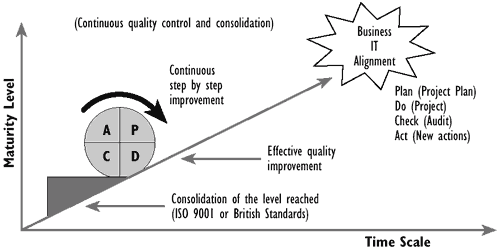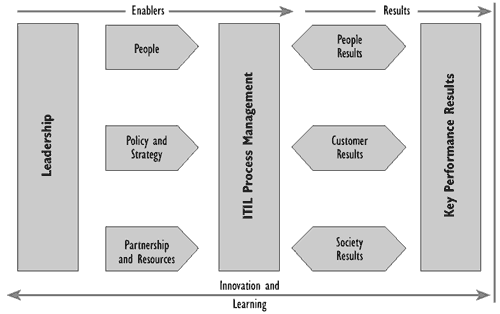Quality Management for IT Services is a systematic way of ensuring that all the activities necessary to design, develop and implement IT services which satisfy the requirements of the organisation and of Users take place as planned and that the activities are carried out cost effectively.
The way that an organisation plans to manage its operations so that it delivers quality services, is specified by its quality management system. The quality management system defines the organisational structure, responsibilities, policies, procedures, processes, standards and resources required to deliver quality IT services. However, a quality management system will only function as intended if management and staff are committed to achieving its objectives.
W. Edwards Deming is best known for his management philosophy establishing quality, productivity, and competitive position. As part of this philosophy, he formulated 14 points of attention for managers. Some of these points are more appropriate to Service Management than others, for example:
|
Excerpts from Deming's fourteen points relevant to Service Management
|
For quality improvement, Deming proposed the Deming Cycle (or Circle). The four key stages are plan, do, check and act, after which a phase of consolidation prevents the 'Circle' from 'rolling down the hill' as illustrated in Figure D.1. The consolidation phase enables the organisation to take stock of what has been taking place and to ensure that improvements are embedded. Often, a series of improvements have been made to processes that require documentation (both to allow processes to be repeatable and to facilitate recognition of the achievement of some form of quality standard).
As discussed in Appendix B - Process theory and practice, the cycle is underpinned by a process-led approach to management, where defined processes are in place, the activities are measured for compliance with expected values, and outputs are audited to validate and improve the process.

Figure D.1-The Deming Cycle
An important set of International Standards for Quality Assurance is the ISO 9000 range, a set of five universal standards for a Quality Assurance system that is accepted around the world. At the turn of the millennium, 90 or so countries have adopted ISO 9000 as the cornerstone of their national standards. When you purchase a product or service from a company that is registered to the appropriate ISO 9000 standard, you have important assurances that the quality of what you will receive will be as you expect. For reference purposes, ISO Standards can be ordered directly from the International Standards Institute (see Chapter 12, Bibliography, for details).
The most comprehensive of the standards is ISO 9001. It applies to industries involved in the design, development, manufacturing, installation and servicing of products or services. The standards apply uniformly to companies in any industry and of any size.
More detailed guidance of the IT Infrastructure Library (including comprehensive mapping of ISO clauses to IT Infrastructure Library processes) can be obtained from the ITIL book on Quality Management for IT Services - ISBN 0- 11-330555-9. This book is concerned primarily with putting in place in IT services an ISO-9001-conformant Quality Management system based on Service Management processes; it also touches upon organisational and planning-and- control aspects.
The BSI Code of Practice for IT Service Management is a modern update of the original document PD0005, which was published in 1995. The new code has been written to serve as an introduction to Service Management, and in fact can be used as an introduction to the IT Infrastructure Library. However, the guide is not an official BSI standard; indeed a standard for Service Management does not yet exist. The IT Infrastructure Library is in many countries the de facto standard, and with the help of BSI and ISO it is hoped that a true international standard, based on the ITIL will soon be in place. The BSI Code of Practice covers the established Service Support and Service Delivery processes, as well as some additional topics such as implementing processes. The BSI Code can be ordered from the British Standards Institute (see Chapter 12, Bibliography, for details).
The European Foundation for Quality Management (EFQM) was founded in 1988 by the Presidents of 14 major European companies, with the endorsement of the European Commission. The present membership is in excess of 600 very well respected organisations, ranging from major multinationals and important national companies to research institutes in prominent European universities.
EFQM provides an excellent model for those wishing to achieve business excellence in a programme of continuous improvement.
The mission statement for EFQM is:
The EFQM Excellence Model consists of 9 criteria and 32 subcriteria. It is illustrated in Figure D2.#

Figure D.2-The EFQM Excellence model
In the model there is explicit focus on the value to Users of the 'Plan-Do-Check-Act' cycle to business operations,* and the need to relate everything that is done, and the measurements taken, to the goals of business policy and strategy.
One of the tools provided by EFQM is the self-assessment questionnaire. The self-assessment process allows the organisation to discern clearly its strengths, and also any areas where improvements can be made. The questionnaire process culminates in planned improvement actions, which are then monitored for progress.
In this assessment, progress can be checked against a five-point maturity scale:
To demonstrate a successful adaptation of the EFQM model, some companies aim for the European Quality Award, a process that allows Europe to recognise its most successful organisations and promote them as role models of excellence for others to copy.
The US equivalent to this award is the Malcolm Baldridge Quality Award for Quality management. The Malcolm Baldrige National Quality Improvement Act of 1987, established an annual US National Quality Award. The purpose of the Award was (and still is) to promote awareness of quality excellence, to recognise quality achievements of US companies, and to publicise successful quality strategies.
For the Malcolm Baldridge Award, there are three categories:
The criteria against which firms are judged are:
For the European Quality Award, there are four possible categories:
The criteria against which candidate organisations are measured are:
In the EFQM Excellence model the first four criteria are defined as enablers. Best practice in IT Infrastructure Library process implementations show that placing proper emphasis on these topics will increase the chances for success. The key points for the four enablers are as follows:
Leadership
People management
Policy and strategy
Partnerships and resources
Readers interested in either of the quality programmes mentioned above should refer to Chapter 12, Bibliography, for details of contacts.
Back